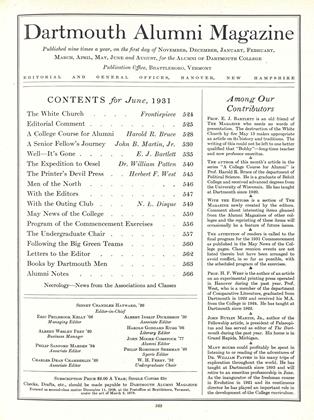THINGS are happening at Dartmouth which would have been impossible a few years ago. I can remember back ten years when the sweat-shirted lads achieved the not impossible feat of hissing the word aesthete with all the facial expressions we associate with the Beery brothers, Wallace and Noah. An aesthete was anyone who did not conform to the he-man model which all good Dartmouth men were supposed to be. The aesthete had afternoon tea, played Red Seal records, wrote poetry, and it was rumoured knew the actual difference between an etching and an engraving. Such men were not comme il faut.
Today, however, the situation is quite different. "Aesthetes" are even honored by campus prestige. Poetry blooms all the year around. An appreciation of the arts is recognized as a legitimate part of the education of every student. Several things have brought about this change. The fine additions to the physical plant of the College, particularly the Baker Library, Sanborn House, and the Carpenter Fine Arts Building, have made a readier access to a study and appreciation of good books and the fine arts. Exhibitions in Carpenter Hall bring to the undergraduates examples of modern painting, etching, and engraving. Artists come to instruct. A studio is at the disposal of those interested in trying to draw or paint.
The publication of the Arts Society called the "Arts Quarterly" has a format which any booklover can cherish. Students rush to subscribe to the Colophon as their elders once bought the Saturday Evening Post. The Renaissance is on.
Let me be not misunderstood. The millenium has not yet arrived. A fine production this year of Gilbert and Sullivan's Mikado failed to get the student support it should have had. But there are signs and portents of better things to be. One of these signs is the establishment of a private press by two students. The visit to Hanover of Mr. Elmer Adler of the Pynson printers supplied, perhaps, the impetus.
PRESENTING THE PRINTERS
Let them speak for themselves:
"Frank Beidler Cornell and Abner Joseph Epstein at this time announce the founding of the Printer's Devil Press, established at Hanover, New Hampshire, as a venture in experimental printing, and as the realization of an ideal of creating original and beautiful work in the field of typography. Harold Goddard Rugg, by his interest and assistance, has materially aided in establishing this press which we, as two undergraduates of Dartmouth College, hope to make, if not a necessary adjunct of the college, at least a concrete manifestation of undergraduate interest and initiative in this branch of the arts."
The press is a small hand press with several fonts of Kennerley old style type, designed by Frederick W. Goudy, in 12 and 20 point type.
The output of the press, it must be admitted, has been small. In the late winter of 1930 came the announcement of the press from which I have quoted above. In the spring 300 copies were printed announcing the Sanborn House Club. This was a four page pamphlet but larger than their first announcement. The press then issued a few sheets explaining their colophon, which was a figure of a printer's devil, circumscribed by a circle, and holding in his hands two letters P and D. This was designed by Mr. Epstein and was printed to complete a display of the work of the press to date, which was part of an art exhibit in the Baker Library.
Not until the present year did the press demonstrate what it could really do. This was a more ambitious piece of work and consisted of a pamphlet, x 10 inches, of about a dozen pages. The title was "Shadows in Stone," a sequence of three poems reflecting the changing moods of a great city, and was written by Carlos H. Baker '32. It was decorated with three linoleum cut prints by Abner J. Epstein. One hundred and twenty-five copies were printed and were numbered and signed by the author and illustrator.
The pamphlet deserves praise as it is a creditable piece of printing. The linoleum cut prints could, with profit, be darker. The spacing leaves something to be desired. Nevertheless, the pamphlet is the first real attempt at student printing and with the type and materials at their disposal the result is remarkably good.
Other things were planned but lack of time and the pressure of other work has prevented anything since. More fonts of type must be had before a bigger piece of work can be attempted.
The founders of the press hope that some other undergraduates will take over the press and carry on. It has real possibilities not only for the enjoyment and fun of it, but also for significant results.
A. J. EPSTEIN
F. B. CORNELL)
 View Full Issue
View Full Issue
More From This Issue
-
 Class Notes
Class NotesCLASS OF 1930
June 1931 By Albert I. Dickerson -
 Article
ArticleA Senior Fellow's Journey
June 1931 By John Butlin Martin, Jr. -
 Class Notes
Class NotesCLASS OF 1929
June 1931 By F. W. Andres -
 Article
ArticleThe Dartmouth Expedition to the Island of Oesel
June 1931 By Wm. Patten -
 Class Notes
Class NotesCLASS OF 1910
June 1931 -
 Lettter from the Editor
Lettter from the EditorEditorial Comment
June 1931
Herbert F. West
Article
-
 Article
ArticleCOLLEGE CO-OPERATES WITH HANOVER HIGH SCHOOL
June 1916 -
 Article
ArticleMasthead
May, 1923 -
 Article
ArticleINCOME AND EXPENSE SHOWN ON A PER STUDENT BASIS
November 1939 -
 Article
Article1890
May 1939 By CHARLES A. HARDY -
 Article
ArticleClass of 1916
Jan/Feb 2005 By Sue DuBois '05 -
 Article
ArticleA FRATERNITY REVIEW
June 1947 By THOMAS W. GERBER '43






